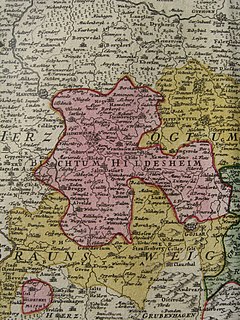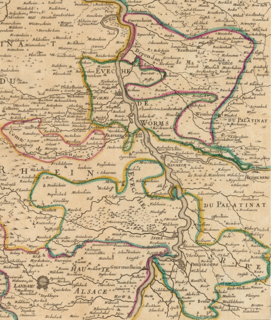 W
WThe Prince-Bishopric of Augsburg was one of the prince-bishoprics of the Holy Roman Empire, and belonged to the Swabian Circle. It should not be confused with the larger diocese of Augsburg, over which the prince-bishop exercised only spiritual authority.
 W
WThe Prince-Bishopric of Bamberg was an ecclesiastical State of the Holy Roman Empire. It goes back to the Roman Catholic Diocese of Bamberg established at the 1007 synod in Frankfurt, at the behest of King Henry II to further expand the spread of Christianity in the Franconian lands. The bishops obtained the status of Imperial immediacy about 1245 and ruled their estates as Prince-bishops until they were subsumed to the Electorate of Bavaria in the course of the German Mediatisation in 1802.
 W
WThe Prince-Bishopric of Brandenburg was an ecclesiastical principality of the Holy Roman Empire from the 12th century until it was secularized during the second half of the 16th century. It should not be confused with the larger Diocese of Brandenburg established by King Otto I of Germany in 948, in the territory of the Marca Geronis east of the Elbe river. The diocese, over which the prince-bishop exercised only spiritual authority, was a suffragan diocese of the Archdiocese of Magdeburg, its seat was Brandenburg an der Havel.
 W
WThe Prince-Archbishopric of Bremen, also Archbishopric of Bremen, — not to be confused with the former Archdiocese of Bremen, and the modern Archdiocese of Hamburg, founded in 1994 — was an ecclesiastical principality (787–1566/1648) of the Holy Roman Empire, which after its definitive secularization in 1648, became the hereditary Duchy of Bremen. The prince-archbishopric, which was under the secular rule of the archbishop, consisted of about a third of the diocesan territory. The city of Bremen was de facto and de jure not part of the prince-archbishopric. Most of the prince-archbishopric lay rather in the area to the north of the city of Bremen, between the Weser and Elbe rivers. Even more confusingly, parts of the prince-archbishopric belonged in religious respect to the neighbouring diocese of Verden, making up 10% of its diocesan territory.
 W
WThe Prince-Bishopric of Eichstätt was a small ecclesiastical principality of the Holy Roman Empire. Centered on the town of Eichstätt, it was located in the present-day state of Bavaria, somewhat to the west of Regensburg, to the north of Neuburg an der Donau and Ingolstadt, to the south of Nuremberg, and to the southeast of Ansbach.
 W
WThe Diocese of Halberstadt was a Roman Catholic diocese from 804 until 1648. From 1180, the bishops or administrators of Halberstadt ruled a state within the Holy Roman Empire, the prince-bishopric of Halberstadt. The diocesan seat and secular capital was Halberstadt in present-day Saxony-Anhalt.
 W
WThe Bishopric of Havelberg was a Roman Catholic diocese founded by King Otto I of Germany in 946, from 968 a suffragan to the Archbishops of Magedeburg. A Prince-bishopric (Hochstift) from 1151, Havelberg as a result of the Protestant Reformation was secularised and finally annexed by the margraves of Brandenburg in 1598.
 W
WThe Prince-Bishopric of Hildesheim was an ecclesiastical principality of the Holy Roman Empire from the Middle Ages until its dissolution in 1803. The Prince-Bishopric must not be confused with the Diocese of Hildesheim, which was larger and over which the prince-bishop exercised only the spiritual authority of an ordinary bishop.
 W
WThe Bishopric of Lebus was a Roman Catholic diocese of Poland and later an ecclesiastical territory of the Holy Roman Empire. It existed from 1125 until 1598. The diocese encompassed areas on both sides of the Oder River around the town of Lebus/Lubusz later called Lubusz Land.
 W
WThe Prince-Bishopric of Lübeck, was an ecclesiastical principality of the Holy Roman Empire until 1803. Originally ruled by Roman-Catholic bishops, after 1586 it was ruled by lay administrators and bishops who were members of the Protestant Holstein-Gottorp line of the House of Oldenburg. The prince-bishops had seat and vote on the Ecclesiastical Bench of the College of Ruling Princes of the Imperial Diet.
 W
WThe Archbishopric of Magdeburg was a Roman Catholic archdiocese (969–1552) and Prince-Archbishopric (1180–1680) of the Holy Roman Empire centered on the city of Magdeburg on the Elbe River.
 W
WThe Electorate of Mainz, previously known in English as Mentz and by its French name Mayence, was one of the most prestigious and influential states of the Holy Roman Empire. In the Roman Catholic hierarchy, the Archbishop-Elector of Mainz was the Primate of Germany, a purely honorary dignity that was unsuccessfully claimed from time to time by other archbishops. There were only two other ecclesiastical Prince-electors in the Empire: the Electorate of Cologne and the Electorate of Trier.
The Bishopric of Merseburg was an episcopal see on the eastern border of the medieval Duchy of Saxony with its centre in Merseburg, where Merseburg Cathedral was constructed. The see was founded in 967 by Emperor Otto I at the same time in the same manner as those of Meissen and Zeitz, all suffragan dioceses of the Archbishopric of Magdeburg as part of a plan to bind the adjacent Slavic ("Wendish") lands in the Saxon Eastern March beyond the Saale River more closely to the Holy Roman Empire.
 W
WThe Bishopric of Minden was a Roman Catholic diocese and a state, the Prince-Bishopric of Minden, of the Holy Roman Empire. Its capital was Minden which is in modern-day Germany.
 W
WThe Prince-Bishopric of Münster was a large ecclesiastical principality in the Holy Roman Empire, located in the northern part of today's North Rhine-Westphalia and western Lower Saxony. From the sixteenth to the eighteenth centuries, it was often held in personal union with one or more of the nearby ecclesiastical principalities of Cologne, Paderborn, Osnabrück, Hildesheim, and Liège.
 W
WThe Prince-Bishopric of Naumburg-Zeitz was a medieval diocese in the central German area between Leipzig in the east and Erfurt in the west. The seat of the bishop was Zeitz Cathedral in Zeitz from 968 and 1029 and Naumburg Cathedral in Naumburg between 1029 and 1615. It was dissolved in the wake of the Reformation. The Bishopric of Zeitz-Naumburg encompassed the four archdeaconries of Naumburg, Zeitz, Altenburg and "trans Muldam".
 W
WThe Prince-Bishopric of Osnabrück) was an ecclesiastical principality of the Holy Roman Empire from 1225 until 1803. It should not be confused with the Diocese of Osnabrück, which was larger and over which the prince-bishop exercised only the spiritual authority of an ordinary bishop. It was named after its capital, Osnabrück.
 W
WThe Diocese of Passau is a Roman Catholic diocese in Germany that is a suffragan of the Archdiocese of Munich and Freising. Though similar in name to the Prince-Bishopric of Passau—an ecclesiastical principality that existed for centuries until it was secularized in 1803—the two are entirely different entities. The diocese covers an area of 5,442 km².
 W
WThe Prince-Bishopric of Freising was an ecclesiastical principality of the Holy Roman Empire from 1294 until its secularisation in the early years of the 19th century.
 W
WThe Prince-Bishopric of Paderborn was an ecclesiastical principality (Hochstift) of the Holy Roman Empire from 1281 to 1802.
 W
WThe Princely Abbey of Corvey is a former Benedictine abbey and ecclesiastical principality now in North Rhine-Westphalia, Germany. It was one of the half-dozen self-ruling princely abbeys of the Holy Roman Empire from the late Middle Ages until 1792 when Corvey was elevated to a prince-bishopric. Corvey, whose territory extended over a vast area, was in turn secularized in 1803 in the course of the German mediatisation and absorbed into the newly created Principality of Nassau-Orange-Fulda. In 2014, the former abbey church was listed as a UNESCO World Heritage Site.
 W
WThe Bishopric of Ratzeburg, centered on Ratzeburg in Northern Germany, was originally a suffragan to the Archdiocese of Hamburg, which transformed into the Archdiocese of Bremen in 1072.
 W
WThe Prince-Bishopric of Speyer, formerly known as Spires in English, was an ecclesiastical principality in what are today the German states of Rhineland-Palatinate and Baden-Württemberg. It was secularized in 1803. The prince-bishop resided in Speyer, a Free Imperial City, until the 14th century when he moved his residence to Uddenheim (Philippsburg), then in 1723 to Bruchsal, in large part due to the tense relationship between successive prince-bishops and the civic authorities of the Free City, officially Protestant since the Reformation. The prince-provostry of Wissemburg in Alsace was ruled by the prince-bishop of Speyer in a personal union.
 W
WThe historic territory of Verden emerged from the Monarchs of the Frankish Diocese of Verden in the area of present-day central and northeastern Lower Saxony and existed as such until 1648. The territory managed by secular lords for the bishops was not identical with that of the bishopric, but was located within its boundaries and made up about a quarter of the diocesan area. The territory was referred to at the time as Stift Verden or Hochstift Verden, roughly equating to Prince-Bishopric of Verden. This territory described in local sources today incorrectly as Bistum Verden and, in 1648, was given the title Principality of Verden, sometimes referred to as the Duchy of Verden.
 W
WThe Prince-Bishopric of Worms, was an ecclesiastical principality of the Holy Roman Empire. Located on both banks of the Rhine around Worms just north of the union of that river with the Neckar, it was largely surrounded by the Electorate of the Palatinate. Worms had been the seat of a bishop from Roman times. From the High Middle Ages on, the prince-bishops' secular jurisdiction no longer included the city of Worms, which was an Imperial Free City and which became officially Protestant during the Reformation. The prince-bishops however retained jurisdiction over the Cathedral of Worms inside the city.
 W
WThe Prince-Bishopric of Würzburg was an ecclesiastical principality of the Holy Roman Empire located in Lower Franconia west of the Prince-Bishopric of Bamberg. Würzburg had been a diocese since 743. As definitely established by the Concordat of 1448, bishops in Germany were chosen by the canons of the cathedral chapter and their election was later confirmed by the pope. Following a common practice in Germany, the prince-bishops of Würzburg were frequently elected to other ecclesiastical principalities as well. The last few prince-bishops resided at the Würzburg Residence, which is one of the grandest baroque palaces in Europe.